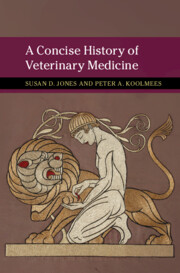Refine search
Actions for selected content:
10296 results in History of science: general interest
Appendices
-
- Book:
- A Concise History of Veterinary Medicine
- Published online:
- 11 August 2022
- Print publication:
- 25 August 2022, pp 375-379
-
- Chapter
- Export citation
Preface
-
- Book:
- A Concise History of Veterinary Medicine
- Published online:
- 11 August 2022
- Print publication:
- 25 August 2022, pp xv-xvi
-
- Chapter
- Export citation
Further Reading
-
- Book:
- A Concise History of Veterinary Medicine
- Published online:
- 11 August 2022
- Print publication:
- 25 August 2022, pp 380-397
-
- Chapter
- Export citation
4 - Veterinary Institutions and Animal Plagues, 1800–1900
-
- Book:
- A Concise History of Veterinary Medicine
- Published online:
- 11 August 2022
- Print publication:
- 25 August 2022, pp 134-201
-
- Chapter
- Export citation
Illustrations
-
- Book:
- A Concise History of Veterinary Medicine
- Published online:
- 11 August 2022
- Print publication:
- 25 August 2022, pp vi-xi
-
- Chapter
- Export citation

A Concise History of Veterinary Medicine
-
- Published online:
- 11 August 2022
- Print publication:
- 25 August 2022
Visual duplication: specimens, works of art and photographs at the Musée d'ethnographie du Trocadéro (1928–1935)
-
- Journal:
- The British Journal for the History of Science / Volume 55 / Issue 3 / September 2022
- Published online by Cambridge University Press:
- 08 August 2022, pp. 365-388
- Print publication:
- September 2022
-
- Article
- Export citation
Globalizing ‘science and religion’: examples from the late Ottoman Empire
-
- Journal:
- The British Journal for the History of Science / Volume 55 / Issue 4 / December 2022
- Published online by Cambridge University Press:
- 02 August 2022, pp. 445-458
- Print publication:
- December 2022
-
- Article
- Export citation
Acknowledgments
-
- Book:
- The Correspondence of Charles Darwin
- Published online:
- 24 June 2022
- Print publication:
- 07 July 2022, pp xxxiii-xxxvi
-
- Chapter
- Export citation
The Wedgwood and Darwin Families up to 1881
-
- Book:
- The Correspondence of Charles Darwin
- Published online:
- 24 June 2022
- Print publication:
- 07 July 2022, pp xlvi-xlvii
-
- Chapter
- Export citation
Appendix III - Diploma presented to Charles Darwin
-
- Book:
- The Correspondence of Charles Darwin
- Published online:
- 24 June 2022
- Print publication:
- 07 July 2022, pp 700-700
-
- Chapter
- Export citation
Appendix I - Translations of letters
-
- Book:
- The Correspondence of Charles Darwin
- Published online:
- 24 June 2022
- Print publication:
- 07 July 2022, pp 637-696
-
- Chapter
- Export citation
Manuscript Alterations and Comments
-
- Book:
- The Correspondence of Charles Darwin
- Published online:
- 24 June 2022
- Print publication:
- 07 July 2022, pp 710-730
-
- Chapter
- Export citation
Frontmatter
-
- Book:
- The Correspondence of Charles Darwin
- Published online:
- 24 June 2022
- Print publication:
- 07 July 2022, pp vi-vi
-
- Chapter
- Export citation
Index
-
- Book:
- The Correspondence of Charles Darwin
- Published online:
- 24 June 2022
- Print publication:
- 07 July 2022, pp 909-976
-
- Chapter
- Export citation
Appendix V - Reviews of Earthworms
-
- Book:
- The Correspondence of Charles Darwin
- Published online:
- 24 June 2022
- Print publication:
- 07 July 2022, pp 705-709
-
- Chapter
- Export citation
Frontispiece
-
- Book:
- The Correspondence of Charles Darwin
- Published online:
- 24 June 2022
- Print publication:
- 07 July 2022, pp 1-2
-
- Chapter
- Export citation
Calendar List of Letters
-
- Book:
- The Correspondence of Charles Darwin
- Published online:
- 24 June 2022
- Print publication:
- 07 July 2022, pp ix-xvi
-
- Chapter
- Export citation
Dedication
-
- Book:
- The Correspondence of Charles Darwin
- Published online:
- 24 June 2022
- Print publication:
- 07 July 2022, pp v-v
-
- Chapter
- Export citation
Introduction
-
- Book:
- The Correspondence of Charles Darwin
- Published online:
- 24 June 2022
- Print publication:
- 07 July 2022, pp xvii-xxxii
-
- Chapter
- Export citation
